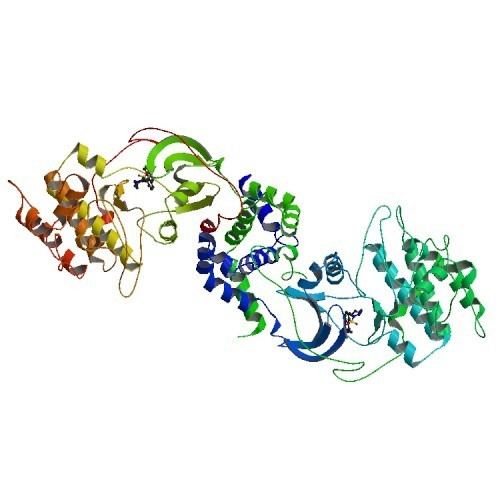Entrez 579202 | EC number 2.7.11.1 | |
 | ||
Alt. symbols Rho-associated, coiled-coil-containing protein kinase | ||
Rho-associated protein kinase (ROCK) is a kinase belonging to the AGC (PKA/ PKG/PKC) family of serine-threonine kinases. It is involved mainly in regulating the shape and movement of cells by acting on the cytoskeleton.
Contents
ROCKs (ROCK1 and ROCK2) occur in mammals (human, rat, mouse, cow), zebrafish, Xenopus, invertebrates (C. elegans, mosquito, Drosophila) and chicken. Human ROCK1 has a molecular mass of 158 kDa and is a major downstream effector of the small GTPase RhoA. Mammalian ROCK consists of a kinase domain, a coiled-coil region and a Pleckstrin homology (PH) domain, which reduces the kinase activity of ROCKs by an autoinhibitory intramolecular fold if RhoA-GTP is not present.
Rat ROCKs were discovered as the first effectors of Rho and they induce the formation of stress fibers and focal adhesions by phosphorylating MLC (myosin light chain). Due to this phosphorylation, the actin binding of myosin II and, thus, the contractility increases. Two mouse ROCK isoforms ROCK1 and ROCK2 have been identified. ROCK1 is mainly expressed in the lung, liver, spleen, kidney and testis. However, ROCK2 is distributed mostly in the brain and heart.
Function
ROCK plays a role in a wide range of different cellular phenomena, as ROCK is a downstream effector protein of the small GTPase Rho, which is one of the major regulators of the cytoskeleton.
1. ROCK is a key regulator of actin organization and thus a regulator of cell migration as follows:
Different substrates can be phosphorylated by ROCKs, including LIM kinase, myosin light chain (MLC) and MLC phosphatase. These substrates, once phosphorylated, regulate actin filament organization and contractility as follows:
ROCK inhibits the depolymerization of actin filaments indirectly: ROCK phosphorylates and activates LIM kinase, which in turn phosphorylates ADF/cofilin, thereby inactivating its actin-depolymerization activity. This results in the stabilization of actin filaments and an increase in their numbers. Thus, over time actin monomers that are needed to continue actin polymerization for migration become limited. The increased stable actin filaments and the loss of actin monomers contribute to a reduction of cell migration.
ROCK also regulates cell migration by promoting cellular contraction and thus cell-substratum contacts. ROCK increases the activity of the motor protein myosin II by two different mechanisms:
Thus in both cases, ROCK activation by Rho induces the formation of actin stress fibers, actin filament bundles of opposing polarity, containing myosin II, tropomyosin, caldesmon and MLC-kinase, and consequently of focal contacts, which are immature integrin-based adhesion points with the extracellular substrate.
2. Other functions and targets
3. Other ROCK targets
Homologues
The two mouse ROCK isoforms, ROCK1 and ROCK2, have high homology. They have 65% amino acid sequences in common and 92% homology within their kinase domains.
ROCKs are homologous to other metazoan kinases such as myotonic dystrophy kinase (DMPK), DMPK-related cell division control protein 42 (Cdc42)-binding kinases (MRCK) and citron kinase. All of theses kinases are composed of a N-terminal kinase domain, a coiled-coil structure and other functional motifs at the C-terminus
Regulation
ROCK is a downstream effector molecule of the Rho GTPase Rho that increases ROCK kinase activity when bound to it.
Autoinhibition
ROCK activity is regulated by the disruption of an intramolecular autoinhibition. In general, the structure of ROCK proteins consists of an N-terminal kinase domain, a coiled-coiled region and a PH domain containing a cystein-rich domain (CRD) at the C-terminal. A Rho-binding domain (RBD) is located in close proximity just in front of the PH domain.
The kinase activity is inhibited by the intramolecular binding between the C-terminal cluster of RBD domain and the PH domain to the N-terminal kinase domain of ROCK. Thus, the kinase activity is off when ROCK is intramolecularly folded. The kinase activity is switched on when Rho-GTP binds to the Rho-binding domain of ROCK, disrupting the autoinhibitory interaction within ROCK, which liberates the kinase domain because ROCK is then no longer intramolecularly folded.
Other regulators
It has also been shown that Rho is not the only activator of ROCK. ROCK can also be regulated by lipids, in particular arachidonic acid, and protein oligomerization, which induces N-terminal transphosphorylation.
Disease
Recent research has shown that ROCK signaling plays an important role in many diseases including diabetes, intracerebral hemorrhage, neurodegenerative diseases such as Parkinson's disease and amyotrophic lateral sclerosis, pulmonary hypertension and cancer. It has been shown to be involved in causing tissue thickening and stiffening around tumours in a mouse model of skin cancer, principally by increasing the amount of collagen in the tissue around the tumour.
Researchers are developing ROCK inhibitors for treating disease. For example, such drugs have potential to prevent cancer from spreading by blocking cell migration, stopping cancer cells from spreading into neighbouring tissue.
